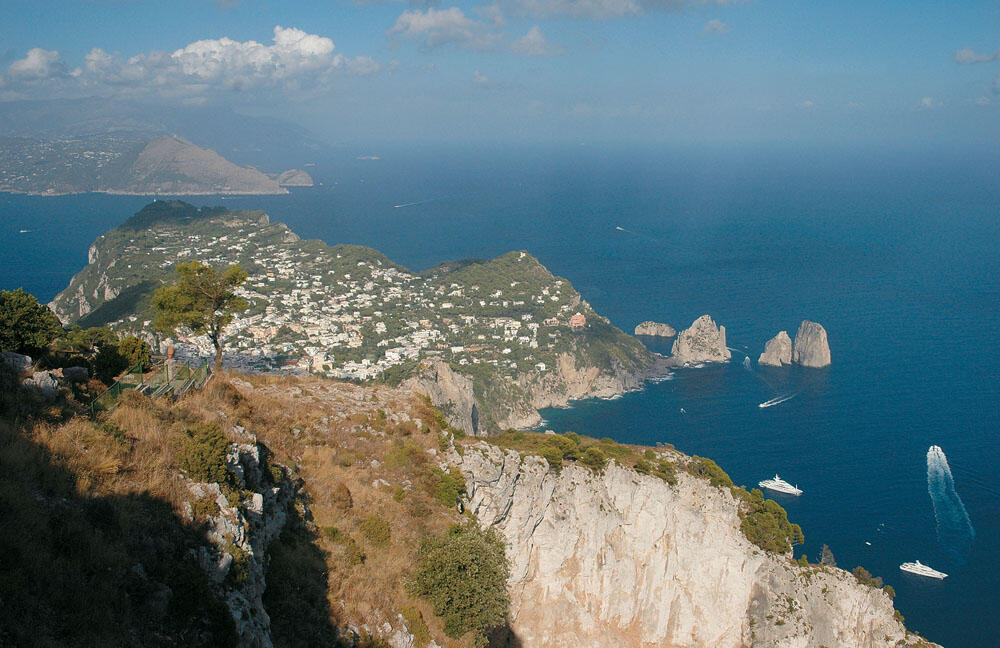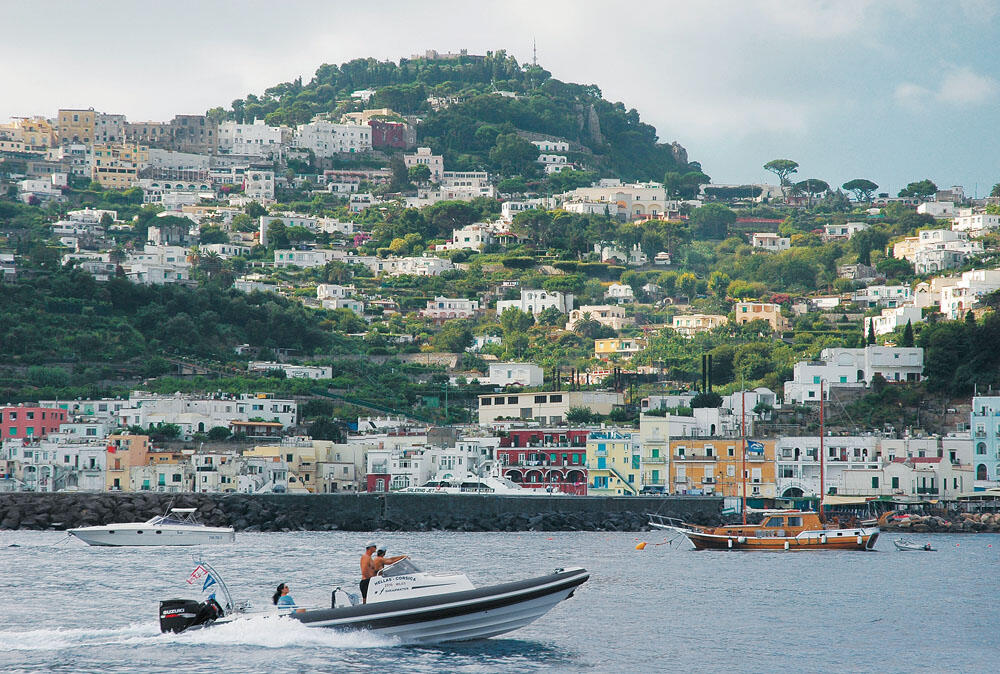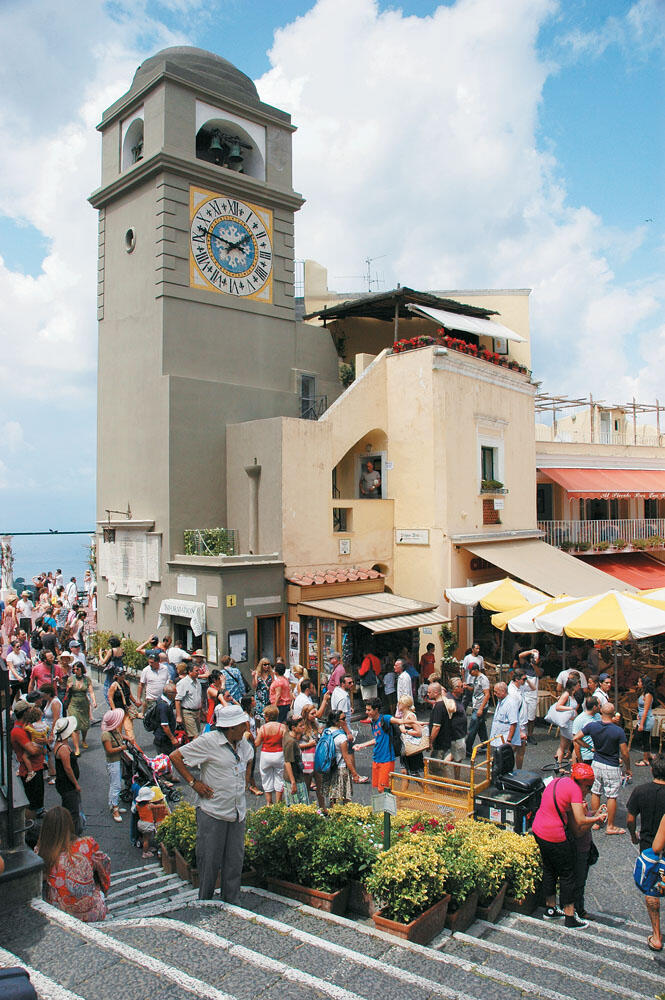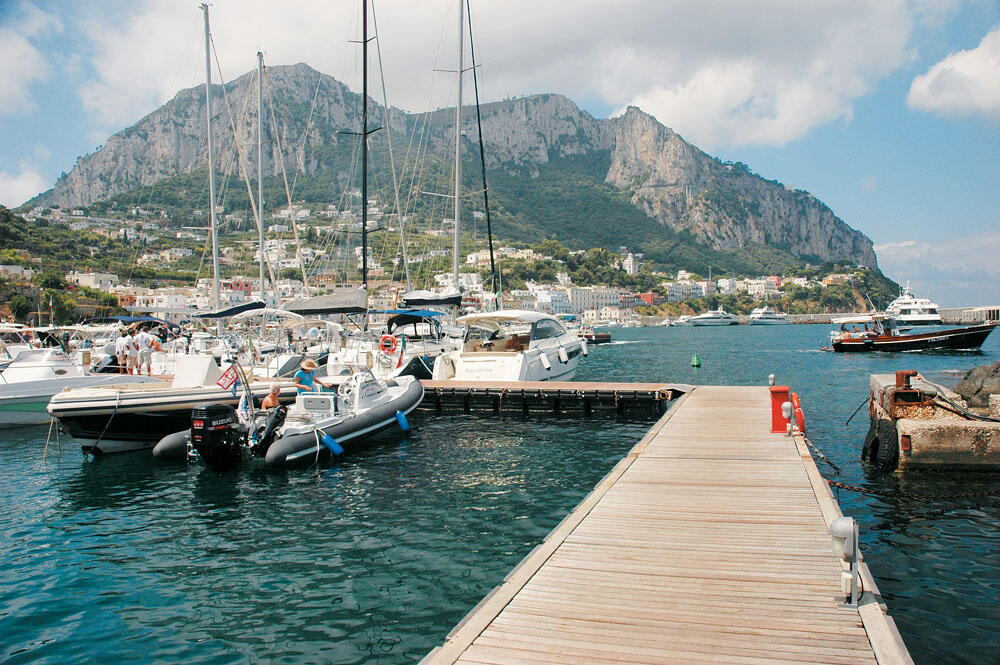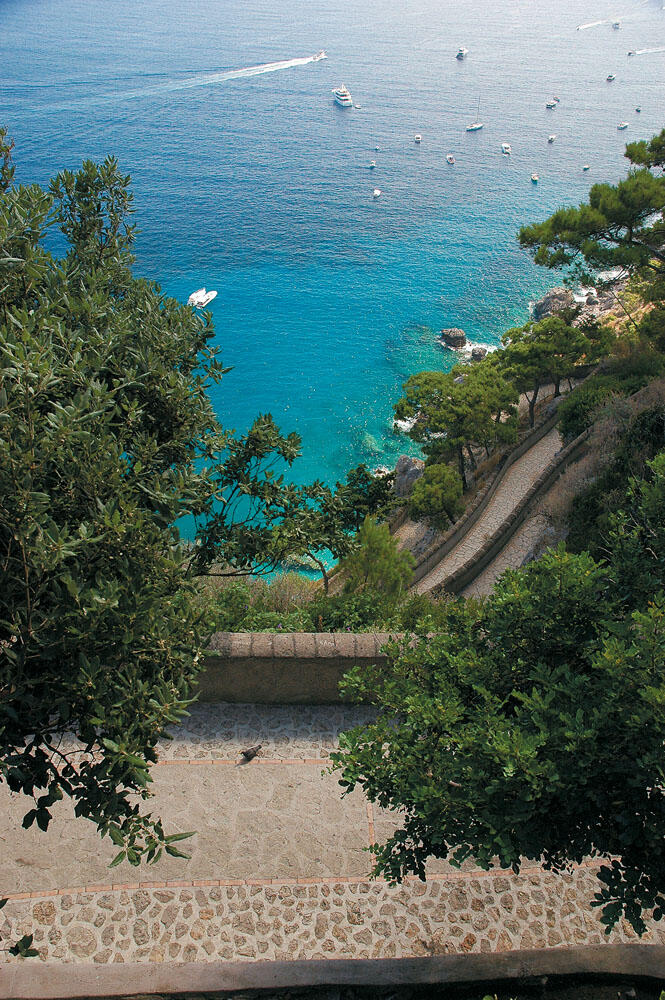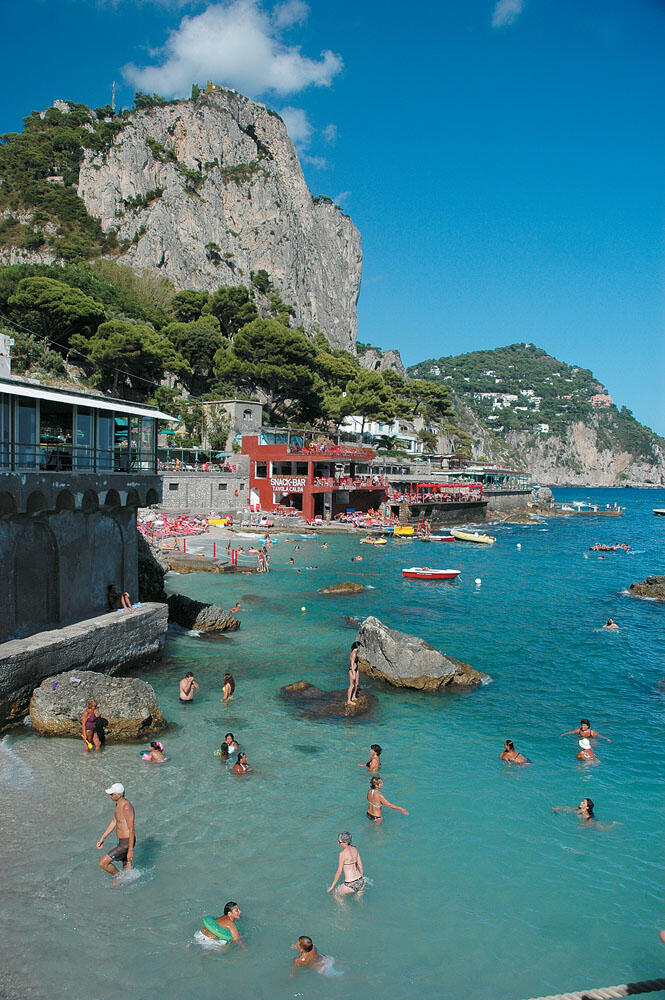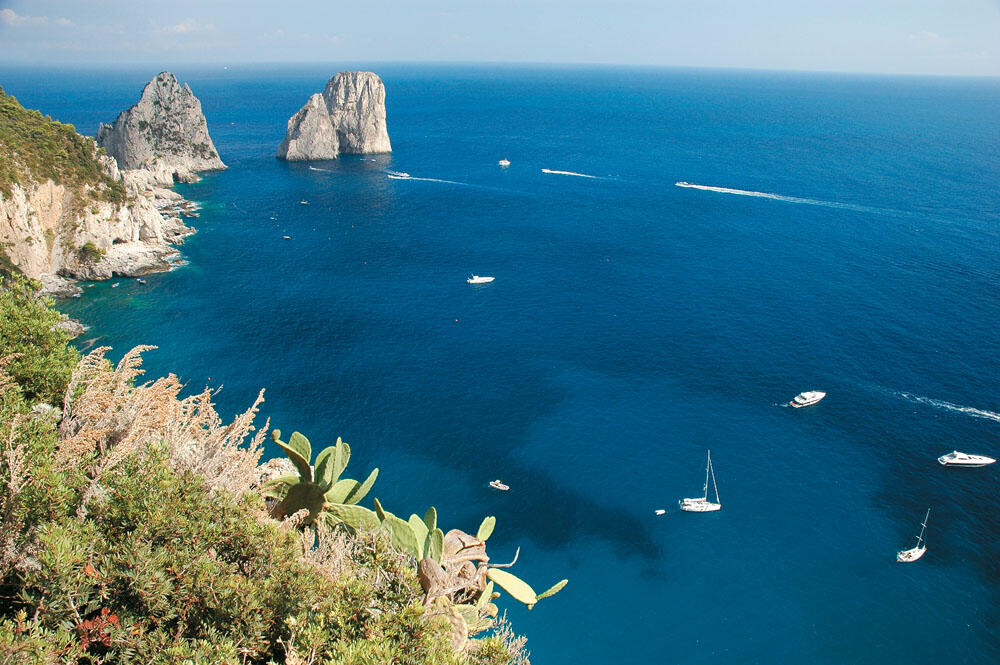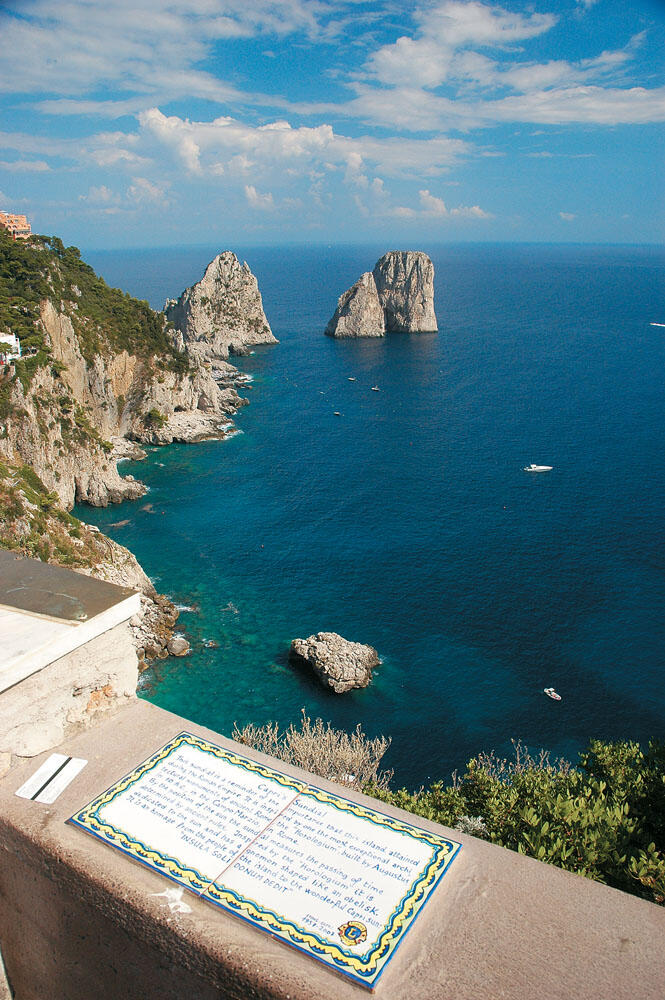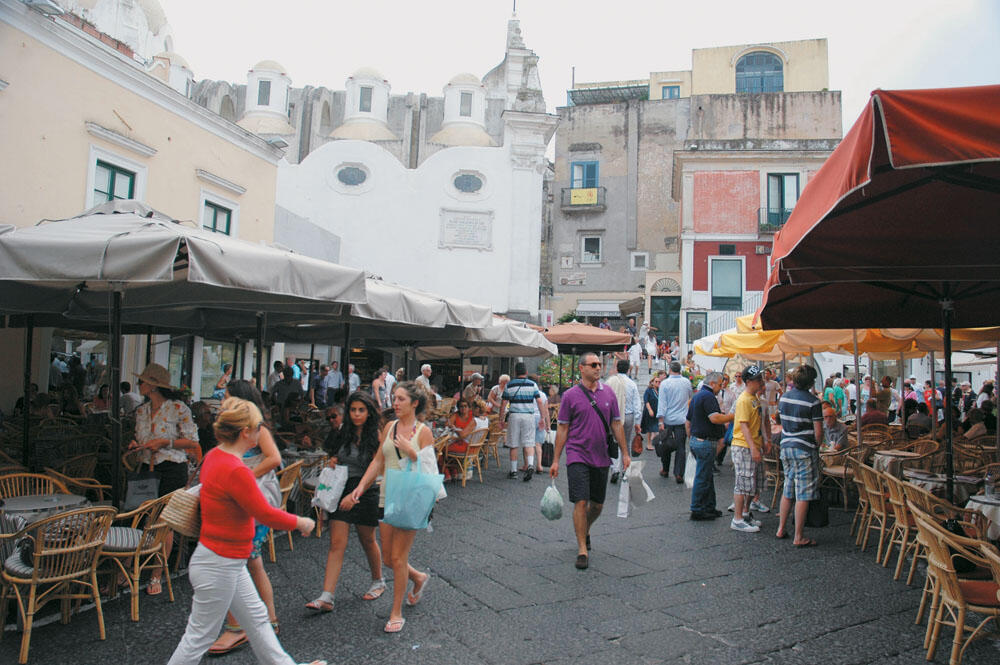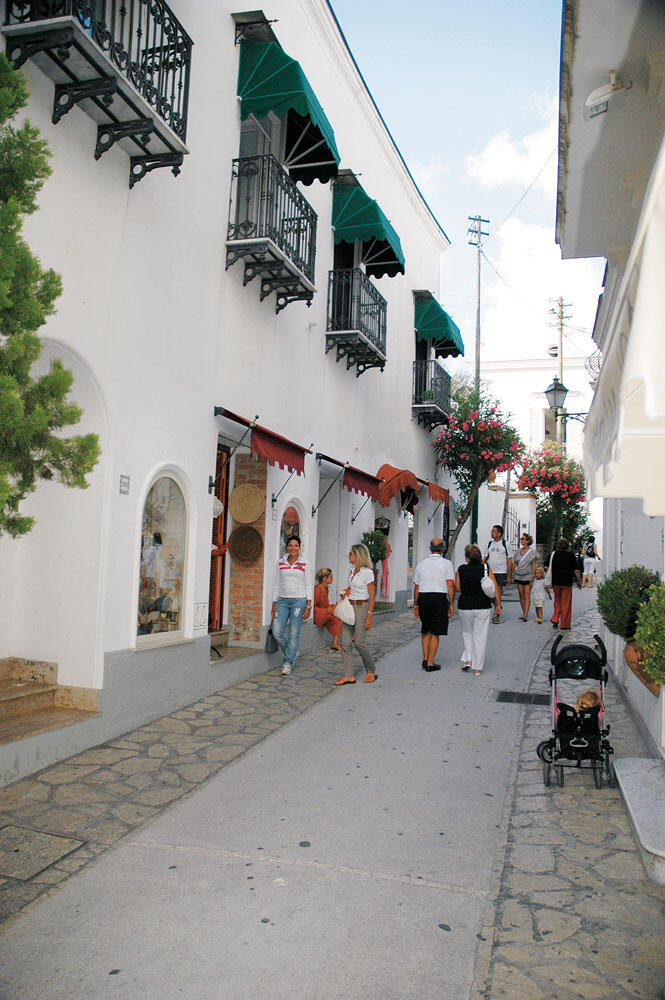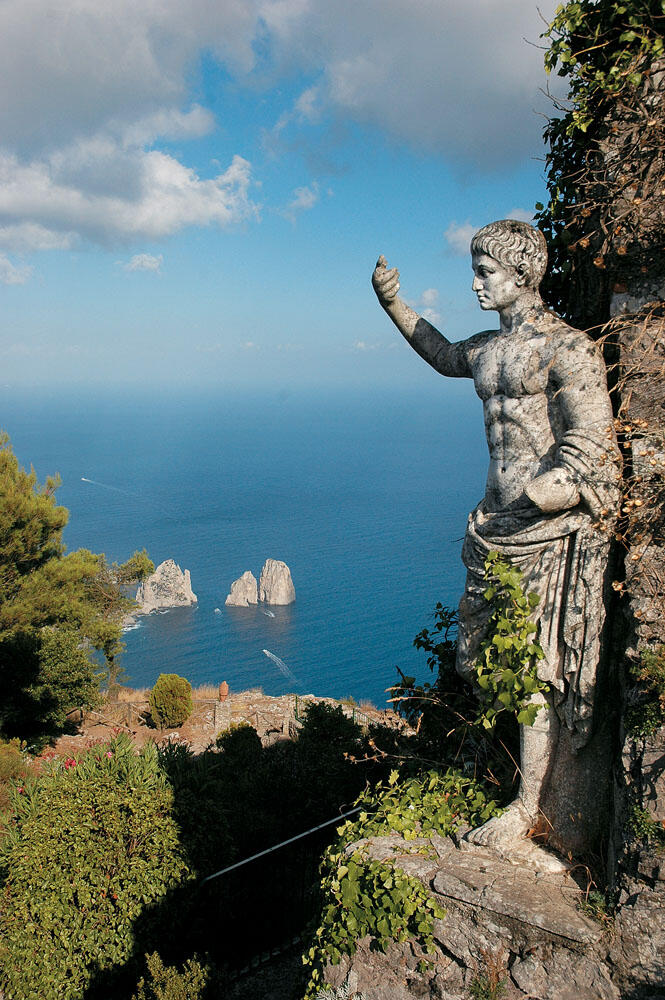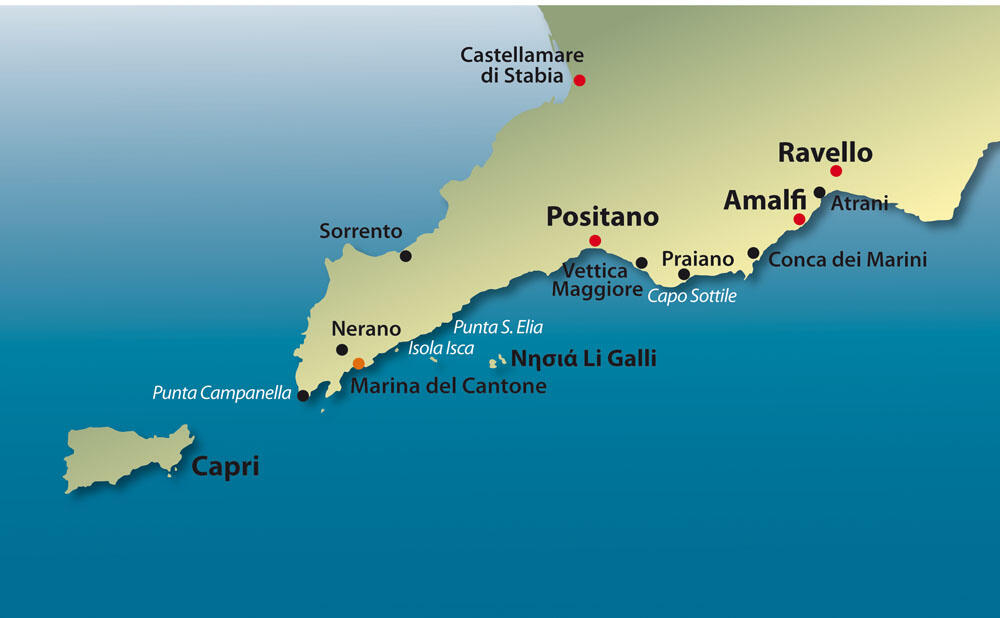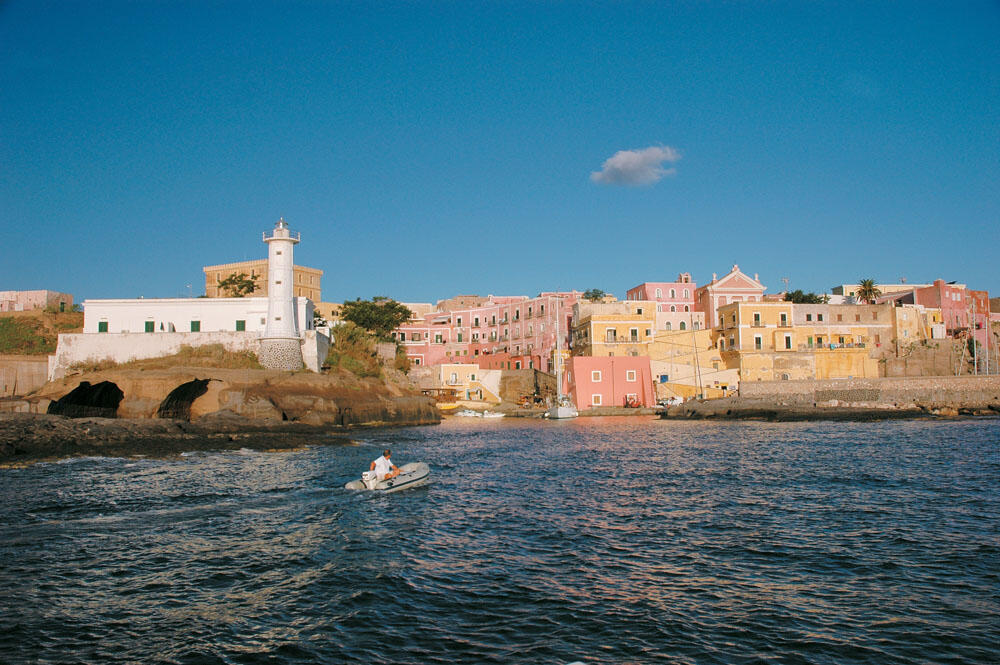
Pontine islands

Wandering around the famous Costiera Amalfitana

Pontine islands

Wandering around the famous Costiera Amalfitana

The island of Capri
Even when I was planning this trip, Capri was one of our most important destinations, since this small island is one of the most famous travel destinations around the world.
Kaprea island according to the ancient Greeks, who named it that way when they first colonized the island during the time of Great Greece due to the presence of many wild boars (boars), is an island with a long history. A tourist resort since the time of the Roman empire, it had so enchanted the emperor Tiberius, who built 12 aristocratic mansions in prominent parts of the island. Capri is one of the most beloved travel destinations from the days of Jack Lemmon and Clark Gable to the current era of Tom Cruise and Brand Pit. And of course, this is not just a coincidence.
Capri is an elegant and refined island, a model of eco-friendly development, combining its enchanting natural beauty with unique architectural houses and picturesque manicured cobbled streets. And all this, with a view of the deep blue sea, which in many places takes your breath away. The whole island seems to be "watered" with a dreamlike atmosphere that has fascinated its visitors for many years. Like a setting from another era, with Roman mansions and well-preserved forts in steep caves, with medieval streets and old churches, with ancient paths that now look like secret passages. The "rock of dreams", as the island is otherwise called, is one of the top travel destinations in Italy, along with Rome, Florence and Venice.
Approaching the port
We were under the lighthouse of Punta Campanella, at the tip of the Sorrento peninsula, from where Capri is just three nautical miles to the west. With the sea calm, we approached the port of Capri located on the northern side of the island.
Marina Grande, as the port is called, is located at the narrowest point of the island, under a green slope with scattered houses. Nestled between the two mountains of the island, the eastern one which reaches an altitude of 335 meters and the western one, which is also the highest and whose peak reaches 589 meters, marina Grande is a bustling port and together with marina Picola, which is located on the south side, they are the two seaside settlements of the island.
But the largest settlements, where most people live, are the Country of Capri, located just above the marina Grande, and Anacapri located on the western side of the island, invisible behind the massif of Solaro. It is characteristic, however, that beyond the four settlements, houses are built all over the island, even in the steepest parts.
Marina Grande is a large port with a lot of traffic in the summer months. On its western side is its commercial section, where ferries from Napoli and Sorrento constantly arrive, but also many tourist boats, suffocatingly full of people. On its eastern side is the marina for pleasure boats, in which, of course, it becomes inseparable. Nevertheless, with a lot of effort and patience, using also some acquaintances we had, we finally managed to secure a place for the night, which cost us 110 euros, a special offer price for us...
From the marina starts a coastal paved road that goes west towards the commercial part of the port, which we followed. It is a busy street, with many people crowding the shops, cafes and restaurants that are lined up and take their tables outside, under the shade of the colorful awnings.
But the heart of the port beats at the western end of marina Grande, where piazza Vittoria is located and is the most central departure point to the various parts of the island. Here is the cable car that takes people to Chora, from here the buses and taxis depart, from here the tickets for the liners are issued. After all, these are the means we can use, since private cars are prohibited on the island.
The cable car, which has been operating since 1907, operates from morning to night and covers a distance of 650 meters to Chora in five minutes of uphill travel. Certainly, it is the best and fastest way to get to Chora, giving us a panoramic view of the island at the same time. The cable car ends at the Loggetta, at an altitude of 138 meters, a square located just behind the famous "Piazzetta", with an unlimited view of the port and the Gulf of Napoli, on the massif of Solaro, with its houses nestled in the green to look towards the sea.
In the "Piazzetta" of Chora
Leaving the cable car for the next day, we preferred to go to Xora with one of the island's specially designed taxis. White and open, with the characteristic sun awning, they are Capri's trademark and run routes to all parts of the island.
Very soon we were at Loggetta, admiring the beautiful view towards the marina Grande. Here is also the tall gray clock tower, on the left side of the entrance to the famous piazza Umberto I.
This square, better known as "Piazzetta" because of its small size, is the most famous point of Capri and also one of the most loved squares in the whole world. This is where the heart of the island beats and as it is said "everyone comes here to see and be seen".
Many decades ago the "Piazzetta" was the outdoor market of Capri. Today, the few buildings overlooking the square have been converted into cafes and restaurants that operate almost 24 hours a day. It is the busiest point of the island, a meeting place for visitors and locals. A very small neighborhood that looks like an open theater stage, where everyone, famous and not, wants to feel like the protagonists even for a few hours. And of course, this is clearly seen in the clothing of most of them, which certainly goes beyond the limits of the ordinary.
Despite the incredible crowds that gather here, the "Piazzetta" still lives up to its legend, continuing to maintain a magical atmosphere that we won't be long in absorbing.
Like from a fairy tale, a small neighborhood with wonderful colors, the perfect place to relax and have fun at the same time. It is certainly an unforgettable experience to sit under the umbrellas enjoying an espresso, a lemon granita or one of the fantastic ice creams and relax while observing the beautiful buildings that surround the Piazzetta or simply watching the people constantly coming and going.
The small square is surrounded by very beautiful buildings of unique architecture. On the east side is the Town Hall, with the characteristic sundial on its facade, on the north side is dominated by the impressive 17th century clock tower known as the "campanile della Piazzetta", while on the west side are the wide steps leading to the Church of St. Stefanou, which is also the largest of the island.
After sitting for about three hours, rummaging and fooling around carelessly, we decided at some point to put an end to this wonderful idleness of ours. So we spread out the map of the island and started plotting our hikes. After all, Capri is the most ideal place for walking!
The small Piazzetta can be bustling with life and the crowds can be intense, but you don't have to go far to find peace and quiet, as all the streets that lead to every corner of the island start from here. After all, the longest distance is covered in less than an hour's walk. You can go to all the attractions on foot, which is a "one way" since there is no other way to get to know the island.
And of course, we can in no way claim to have known Capri if we don't walk it and wander its numerous cobbled streets, that is where the magic of this place is hidden. Fairy-tale cobbled streets, decorated with colorful flowers and tall trees, wonderful paths in the dense vegetation, next to adorable houses, luxurious villas and unique hotels. And all this, in an incredible harmony with the natural landscape, being almost impossible to spot anything ugly or bad taste. At almost every step you take, you are forced to stop to admire the enchanting images unfolding before you. And when you reach the end of the road, a "balcony" awaits you with a breathtaking view of the sea and the rugged coastline.
In the gardens of Augustus
So we started on the south side of the Piazzetta and started down Via Emanuelle. After passing two well-known and beautiful hotels, following the elegant ceramic signs, the cobbled road took us out onto Via Matteoti. A narrow alley, where colorful flowers and dense vegetation dominate. This alley leads to the famous gardens of Augustus, one of the most famous attractions and one of the most beautiful spots on the island. Beautiful flowers and plants in elaborate combinations in the dense vegetation, a feast of vibrant colors that soothe the soul.
Climbing a few steps we come out to the clearing where there is a wonderful balcony on the cliff, with an amazing view towards the Faraglioni rocks.
These rocks, which seem to emerge from the sea at the south-eastern tip of the island, are the most photographed point and trademark of Capri. We sat here for a long time, until the eye was satisfied with this unique sight.
On the protective terrace, at the edge of the cliff, is a marble slab with a small obelisk on its edge, the shadow of which tells us the time. It is an elegant sundial that emphasizes the importance of the island during the Roman Empire. This clock is inspired by a very important monument of ancient Rome, the "Horologium", which was built by Augustus in 10 BC.
We are still on this wonderful balcony and going a few steps further west we have a panoramic view of Marina Piccola.
But if we lower our gaze, we will be ecstatic, when we find that right under our feet is literally hanging in the void a wonderful cobbled street that is carved into the vertical rock. It is the famous Via Krupp, named after the German Alfred Krupp, and is an eternal symbol of freedom and contribution to the beauty of Capri's nature.
This winding road, with its repeated hairpins and protective terraces, is dug into the vertical rock and reaches an altitude of about 100 meters above sea level. So steep is the rock, and so improbable is the geometry of the winding road, that as we look at it from above, its horizontal sections seem to coincide with each other. A masterpiece of engineering and aesthetics, in a perfectly friendly coexistence with the natural landscape, which proves to us that even a road can be an excellent work of art.
Going down Via Krupp!
Via Krupp connects Chora with Marina Piccola. Descending this lovely road we soon arrived at marina Piccola, located about halfway down the south side of the island. It is the smallest of the four settlements of the island and is the southern "port" of Capri, where mainly the tourist boats catch. Of course, there is no marina here, not even a breakwater to protect from the southers. It is a natural and open bay, with a rudimentary dock between the rocks, which only serves the disembarkation and embarkation of visitors to the tourist boats. We can only moor at Arodo, and even outside the buoys that surround the main beach, and go out to the small dock either by swimming or with our tender, if of course we have one.
Marina Piccola is nestled on the verdant hillside nestled between the island's imposing vertical mountains. It is a rocky coast, with restaurants and cafes located along it, on the rocks, while the few houses of the settlement and luxury hotels are literally tucked into the greenery, under the shade of tall pine trees.
A small ledge of rocks, resembling a small and low peninsula of a few tens of meters, divides the bay of marina Piccola in two. On the western side of this ledge there is also the small dokos, from which the concrete street that takes us to land begins.
At the base of this rocky ledge there is the wonderful stone cafe-restaurant "Le Sirene", and two very small pebbly beaches where many people flock. Then the stairs begin that pass between picturesque houses and take us to the station of the characteristic minibuses of the island.
We preferred not to walk back to Chora, but to take the bus, which after a ten-minute uphill ride on the narrow winding road, took us to Chora, dropping us off near the Piazzetta. We walked to the small piazza and before setting off on our second and more strenuous walk, we sat down for a tonic granita-coffee, again enjoying the atmosphere of the magnificent Piazzetta, discussing the wonderful walk we had just taken, walking to marina Piccola. It was a route that if you don't stop anywhere, which is impossible since the landscapes are exceptional, it takes less than half an hour. But the most important thing is that within this short course you meet three of the most famous attractions of Capri: the gardens of Augustus, the wonderful balcony with the amazing view towards the magnificent Faraglioni and of course the amazing via Krupp.
Southeast of the island
After a long rest, we took Via Emanuelle again. Just a few meters down, where Via Vittorio Emanuelle meets the famous Hotel Quisisana, begins Via Camerelle, which is Capri's most famous and most elegant street. This street is an attraction in itself and is considered the heart of shopping. All the boutiques of the famous fashion houses are located here and of course it is the most expensive market on the island.
We turned onto Via Camerelle and admiring the wonderful shops, we emerged onto a small path leading to Via Tragara. This road, away from crowds and congestion, runs southeast and ends at Punta Tragara, which is the southeasternmost tip of the island. It is a very quiet downhill road, which takes us back to the Roman era and is characterized by rich vegetation in which some of the most beautiful houses and hotels of the island are hidden. Magnificent bougainvillea climb the high stone walls of the houses and, together with the colorful flowers and beautiful trees, give Via Tragara a unique beauty.
After a wonderful ride we arrived at another balcony with a great view, right above the famous Faraglioni. It is a cluster of three vertical and high rocks, at very short distances between them, that seem to emerge from the deep sea, offering an incredible sight.
The famous Faraglioni rocks
It is a complex of three vertical and high rocks, famous all over the world.
The first rock, which is also the largest, reaches a height of 111 meters and is called Faraglione di Stella. It is the only one that is connected to the mainland by a flat rocky isthmus and forms a small harbor. At the beginning of this isthmus there is also a very nice cafe-restaurant, in the shadow of the first Faraglioni.
The second rock is the smallest, reaching 81 meters high. It is called Faraglione di Mezzo and is just a few meters from the first one. At a breathing distance is the third rock, which reaches 105 meters in height and is called Faraglione di Scopolo. The only inhabitants of these rocks are a rare species of lizard with blue highlights, which live exclusively here.
The middle rock is without a doubt the most impressive of all, due to the large arch that exists at its base, through which boats and tourist boats pass. This arch is 15 meters high from sea level, 13 meters wide, while its length reaches 56 meters, and surely this is the most important reason why the Faraglioni rocks have become famous all over the world.
We stayed for a long time admiring these unique rocks and finally decided not to return to the Piazzetta by the same road but to take the path that continues to the left of Via Tragara, which circles the south-eastern side of the island and then meets Via Matermania , ending up again in the Piazzetta. In other words, we would make a fairly long circle, which would, however, pass by some unique sights.
So we continued our journey on the narrow path, which follows the relief of the coastline. We had a strong feeling that we were on another island, far from the world, with the precipitous rocks and the deep sea as protagonists. At one point, we found ourselves above the small massullo cave, where the famous house of the Italian writer Curzio Malaparte dominates. It is a red two-storey building, of special architecture, with the characteristic wide stairs that reach up to its roof, which has been an attraction of the island for many years.
Continuing on the path, we were led into a dense oak forest, where everything suddenly became dark, since the sun's rays could not pass through the dense foliage of the trees.
We walked among the hundreds of logs, admiring the amazing view of the wild rocks falling from a great height into the deep waters of the sea. Through an unlikely route in a pristine environment, we arrived outside the entrance of the Grotta di Matermania.
A large cave, at 180 meters above sea level, whose depth reaches 30 meters, its width 20 meters and its height approximately 10 meters. It is believed that this cave was a large nymphaeum in the years of Augustus and Tiberius, a fact that can be seen from the Roman lining of the walls.
Continuing our way through the dense forest, we began to climb the uphill steps, which are as steep as the vertical rocky shores. This is also the most difficult part of the entire route. We finally came out into a small clearing, where some lovely houses could be seen amidst the thick vegetation, their small verandas literally perched on the edge of the cliff, offering a shocking sight to their owners.
In a short time we arrived at the secluded cafe-restaurant Le Grottelle which, tucked among the pines and the steep rocks, is a wonderful place for a few moments of rest with a wonderful view towards the sea. After enjoying an iced lemon granita, we took the downhill path that in a few minutes brought us to another well-known attraction of the island. In the famous Arco Naturale. A work of art of nature, a large arch 12 meters wide and 18 meters high, through which we admire the unique sight of the green waters that lie 200 meters below. Arco Naturale was once a large cave, the roof of which collapsed over the centuries, and today it is one of the most photographed spots on the island.
Quite tired, but full of wonderful images, we returned to the cafe-restaurant Le Grottelle. From here, we entered Via Matermania, another lovely little street which brought us back to our little Piazzetta. This total route took more than two hours and was definitely the most strenuous of all the others. But it was definitely worth it, after meeting some of the most characteristic sights of Capri and walking through a pristine environment, untouched and unspoiled, through wonderful paths and hundreds of steps, while getting to know the most unexplored and perhaps most spectacular side of the island.
With the sun already setting, we enjoyed another cup of coffee and once again enjoyed our little square, which was now the starting point for all our excursions. The first lights were slowly beginning to illuminate the Piazzetta and as time passed, we showed no inclination to move from our seats, wanting to soak up some of the nighttime atmosphere of this Lilliputian neighborhood.
The next day
Early in the morning we were outside the cable car station in the marina Grande, which in a few minutes took us to the Piazzetta, where with the noticeable absence of many people we found ourselves planning our next routes.
We ascended the broad steps which lie on the west side of the piazza, near the church of St. Stephen, and passing through the arches of the Palazzo Cerio, entered a large portico. Here there are some fruit and vegetable shops and some pizzerias with a beautiful view of the harbor that have hosted famous names from time to time.
We finally came out on Via Castello, an uphill narrow alley that in a few minutes led us to a small "balcony". Nestled in the pines and next to the vertical rock, it was the highest point we had visited so far. And of course the view from here is unique.
To our left, almost under our feet, the gardens of Augustus could be clearly seen, while further on dominated the impressive Faraglioni. To our right, the scenery is even more imposing, with the mountain masses literally dropping vertically to the sea from a great height. Among them, in the dense vegetation, stands out the small settlement and the low cave of Marina Piccola.
This is the third route starting at the Piazzetta, which, although it lasts no more than 20 minutes, gives us a magnificent sight and a panoramic view of the entire southern side of the island.
In the Villa Jovis of Tiberius
We returned to the small square again and this time we took Via Le Botteghe with the intention of reaching the north-eastern tip of the island, where the famous Villa Jovis is located. This would be our fourth and final route before leaving the Piazzetta and heading to the west side of the island where Anacapri is located.
We soon reached Via Tiberio, one of Capri's quieter streets. After about an hour's drive, between wonderful houses with large gardens, and walking in the shade of pine trees, we approached the second highest peak of the island after Mount Solaro.
There, at 334 meters above sea level, literally on the edge of the cliff, is Villa Jovis. It is the largest and best preserved of the 12 villas of Tiberius that exist on Capri. This was also his main residence, which is built on several levels and occupies an area of up to seven acres. The reason this spot was chosen to build the villa, on the north-eastern tip of the island, on top of Monte Tiberio, was to ensure maximum security for the emperor and to control the Capri bugaze.
Everywhere you look the view is breathtaking, with the rocks tumbling vertically into the sea from 334 meters.
The point of the villa offers a panoramic view to all points of the horizon. Directly opposite, Punta Campanella, the headland of the Sorrento peninsula, is clearly visible. If we turn west we will admire the whole island with its verdant slopes and the imposing volume of Solaro. A little further down, at the end of the road leading to the villa, is the famous Salto di Tiberio, the spot from where, according to legend, the emperor hurled his unwanted guests.
By midday, we returned to the Piazzetta and of course enjoyed another refreshing lemon granita, before taking the minibus to Anacapri.
Anacapri
In about twenty minutes we reached the northern side of Mount Solaro, the bus seemingly floating on the cliff, giving us a stunning view of the marina Grande and the entire northern side of the island.
Anacapri is the second largest settlement after Chora, built on a large plateau on the western side of Mount Solaro. Invisible from the Marina Grande and Chora, since the almost vertical eastern side of Solaro is interposed, seeming to protect it from the crowd, keeping it out of the public eye, unlike the rest of the island which stars in the lists of travel destinations. With more than 6000 inhabitants, it is the quiet and least developed area of Capri. However, this does not mean that it lacks beauty and attractions, while at the same time it is the ideal place for those who prefer more peace and quiet on their vacations, away from the bustling squares and crowds. Anacapri owes its name to the high location on which it is built and possibly the first compound of its name comes from the Greek word "ano", meaning Upper Capri.
From piazza Vittoria, where the bus dropped us off, begins Via G. Orlandi, Anacapri's main pedestrian street.
It is a fairly long road that crosses the village and is its central market. Many shops in a row, small cafes and restaurants, small squares that gather a lot of people, but without overcrowding. Here everything flows at a daily pace, in a peaceful and very welcoming environment. In the first small square we encountered, is the famous Casa Rossa.
A large red building built between 1876 and 1899 by an eccentric American who lived here. Without having anything to do with the architectural lines of the houses of Anacapri, it is an attraction for passers-by, who are welcomed by an ancient Greek marble inscription, located at the entrance of the "red house".
A little further down, a narrow alley on the right leads us to the square of Agios Nikolaos. Here dominates the great church of St. Michael, which is characteristic for its magnificent mosaic floor and for the unique paintings of great Neapolitan painters, constituting an important monument of Anacapri.
Continuing our walk along the main street between the elegant two-story houses, we arrived at piazza Materita. Here dominates the old all-white church of Agia Sophia, characteristic for its special architecture. It has had an important role since 1680, when the sailors of Anacapri established the island's first pawnshop in the church, where they invested their profits. With this money the sailors endowed their daughters, but often also helped unemployed people who were unable to support their families.
But beyond the main pedestrian street, there are some very important attractions on the outskirts of Anacapri that we should not miss in any way. One of them is the villa St. Michael built by the Swedish writer Axel Munthe, who lived here for many years enchanted by the beauty of the island. Built on the ruins of the ancient church of San Michele, it has been turned into a wonderful museum. Such was Axel Munthe's love for ancient objects, that he built a unique residence filled with ancient marble and columns, with statues and parts of sarcophagi, with unique mosaic floors from neighboring Pompeii and from emperors' palaces.
How do we go to Anacapri...
Anacapri is connected to Chora by a very picturesque road, in many parts of which the view towards the island and the Gulf of Napoli is fantastic. The buses and taxis that start from Xora take us to Anacapri in a few minutes, while for the fanatic hikers there are also the Phoenician steps or Scala Fenicia.
It is a wonderful route of 800 steps that form the ancient road that connected Anacapri to the Marina Grande. This was also the only way to reach Anacapri until 1874, when the road was built. Despite their name, these steps began to be made by the ancient Greeks, who placed large stones and in many places sculpted the rocks creating a large part of the total length of the path. This path of steps starts at the height of the coast near the marina Grande and for the first 500 steps, the steps are very steep as they climb almost vertically up the steep rocks, finally ending at the entrance of the medieval town of Anacapri, near the villa St. Michael.
At the edge of the villa, walking along the cobblestone path under the shade of the pergola supported by marble columns, we reach one of the most beautiful balconies on the island with a stunning view of the marina Grande, Capri and the Sorrento peninsula. A fascinating sight from which it will be very difficult to tear our eyes away. A little further, at the northwestern end of the island, crossing a very beautiful alley with a wonderful view, is one of the most important archaeological sites of the island. The imperial Villa Damecuta dating from the time of Augustus or Tiberius.
At the top of the Solaro
And of course, our ascent to the top of Solaro with the single chairlift would be a unique experience!
We took it from the central Vittoria square and in a few minutes it took us to the top of Solaro, at 589 meters above sea level. Climbing along the western and smoother slope of the island's highest mountain, between beeches and large chestnut trees, we admired from above the great plateau where Anacapri stretches and the entire western side of the island.
The "chair" left us just a few meters from the top of Solaro. We climbed a few steps and reached the ruins of the castle, from where the view is breathtaking in every direction. We were at the highest point of Capri, from where you can admire the whole island, the settlements in the green nature, the steep rocky coasts that descend almost vertically into the dark waters, but also Ischia, the whole bay of Napoli and the peaks of the Apennines further. It is certainly the most panoramic point of the island with a wide view towards the Mediterranean and Italy. With Anacapri having left us very beautiful impressions, offering us peace and unique images, we descended to Chora, returning again to our base, the small Piazzetta. We sat on the wide steps so that we had the whole of it in front of us, as this would be the last view we would have of the lovely little square, which we admittedly enjoyed. But we had missed the sea a lot, since for two whole days we had indulged in a marathon of mountain routes. So we made our way to the port, where the inflatable was patiently waiting for us to take us around the shores of the island.
Around the island
The perimeter of Capri does not exceed 10 nautical miles, so we had the luxury of exploring and enjoying its shores for the whole day. Of course, we knew in advance that Capri is not famous for its beaches, since it is essentially a mountainous place with very steep and rocky coasts surrounded by deep waters. Nevertheless, the tour of the island, without any doubt, is a very beautiful experience.
The pleasure boats that flood the island anchor regularly in certain bays, and people admire the impressive shores more than they enjoy their swimming. As for the bathers who do not have a boat, they are scattered on the sunbeds which have been placed in a row on the rocks or on the coarse pebbles.
So we started from marina Grande and headed west. Very soon we were in the shadow of the vertical banks of the northern side of Mount Solaro. Just before the northwestern tip of the island is the famous Blue Cave or Grotta Azzura, which together with the Faraglioni are the most popular sea attractions of Capri, and gather thousands of people every day.
We arrived a few meters outside the Blue Grotto and despite the fact that it was still very early in the morning, dozens of boats were lined up, while quite a few people, who had come on foot or in minibuses from Anacapri, were waiting patiently on the steps to it's their turn. As time went by, the queue that the people formed grew longer, while the boats that approached became more numerous.
The Blue Cave has a very small opening and the only way to get inside is to wait in line until you board the small boats that are there and take the tour inside.
The wait is certainly worth it since boating inside the Blue Cave is an unforgettable experience (see related insert) and it is no coincidence that it is the island's biggest tourist attraction.
With the colors of the Blue Grotto flooding our memory, we crossed over to the west side of Capri, just below the plateau on which Anacapri is built. The western side stretches for a length of about two nautical miles and is the only side of the island where the green slopes descend relatively smoothly to the sea, creating some beautiful little marshes, but without the presence of beaches. The most beautiful point of this side is its southern end, called Punta Carena. Here is the lighthouse of the same name, which is the second most important lighthouse in the whole of Italy, after the lighthouse of Genoa. It is an impressive octagonal tower, with red and white colors, operating since 1866.
Passing Punta Carena we passed to the south side of the island, where we are greeted by vertical rocks that fall from a great height into the sea, offering us a wonderful sight. The whole of the south side is very impressive and is famous for its steep shores, as well as for the many caves formed at the base of the solid vertical rocks. The waters here are very deep, with no dangerous spots, so we sailed very close to the rocks following the relief of the coastline. A little after halfway down the south side is the Piccola marina, off which many boats are moored.
At the southeast end of the island dominate the Faraglioni, the three towering rocks that are the most spectacular and most photographed attraction of Capri. We slowly made our way through the impressive arch of the middle rock and began to climb up the eastern side of the island. About halfway along this side, which does not exceed two nautical miles in total, is the open bay of Cala di Matermania. It is surrounded by very impressive vertical rocks, while high up is the famous Arco Naturale. It is certainly the most spectacular bay of the island and here the largest number of boats gather, which are moored in the shadow of the towering rocks. In fact, many boats spend the night here, since the master that usually blows in these parts cannot affect Cala di Matermania, which, although it is a very open bay, is one of the windiest parts of Capri.
So we started from marina Grande and headed west. Very soon we were in the shadow of the vertical banks of the northern side of Mount Solaro. Just before the northwestern tip of the island is the famous Blue Cave or Grotta Azzura, which together with the Faraglioni are the most popular sea attractions of Capri, and gather thousands of people every day.
We arrived a few meters outside the Blue Grotto and despite the fact that it was still very early in the morning, dozens of boats were lined up, while quite a few people, who had come on foot or in minibuses from Anacapri, were waiting patiently on the steps to it's their turn. As time went by, the queue that the people formed grew longer, while the boats that approached became more numerous.
The Blue Cave has a very small opening and the only way to get inside is to wait in line until you board the small boats that are there and take the tour inside.
So it didn't take us long to turn around and head a little further south where the more enclosed bay of Porto di Tragara is located, just behind the first Faraglioni. Here things were noticeably better, since a little further on is the islet of Monacone, which protected us quite a bit from the waves of the hundreds of boats coming and going. Here we even decided to spend the night, spending our last night in Capri, next to the unique Faraglioni.
And of course, until it got dark, our conversation turned to Capri and we unanimously concluded that it is an incredible travel destination that is not coincidentally at the top of the list of preferences for many people who arrive here from different parts of the world.
The whole of Capri is a paradise, which we will only discover if we walk and get lost in its medieval streets. Only then will we understand what it is that has enchanted so many people around the world.
...keep Ribbing!

